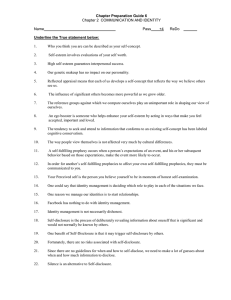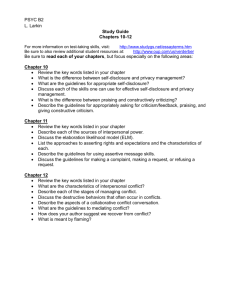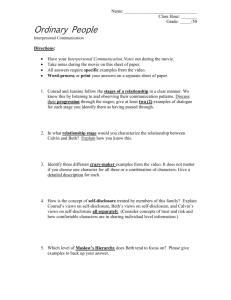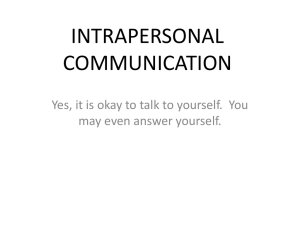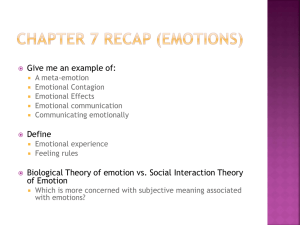Ch. 3-Comm. and Self
advertisement
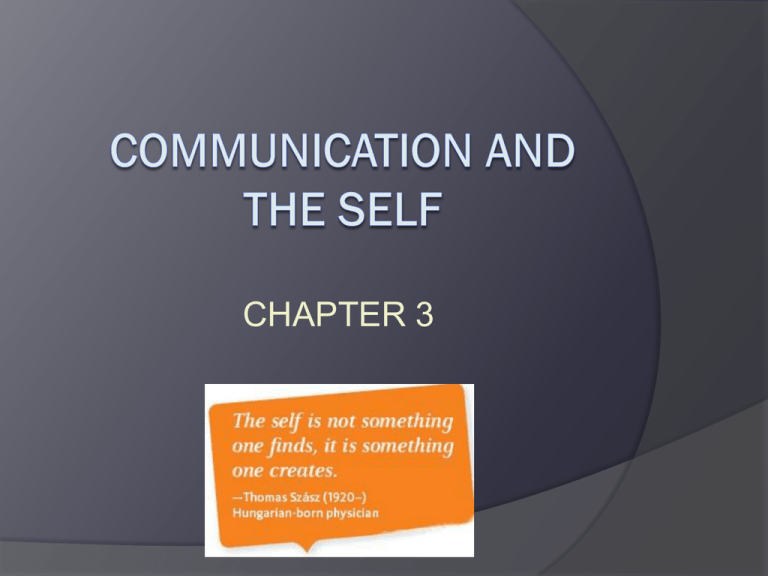
CHAPTER 3 Self Concept Composed of stable ideas about who you are Multifaceted ○ We define ourselves in many ways Partly subjective ○ Based on our impression of ourselves—difficult to judge ourselves objectively Enduring but changeable ○ Significant life events How Self-Concept Develops Personality and Biology Pattern of distinctive ways you tend to think and act across most situations Nature vs. Nuture Culture and Gender Roles How Self-Concept Develops Reflected Appraisal Process where a person’s self-concept is influenced by our beliefs regarding what other people think of us Social Comparison Theory We compare ourselves to others around us Reference Groups Self-Concept Management Self-Monitoring High and low—discussed in Ch. 1 Self-Fulfilling Prophecy A prediction causes people to act and communicate in ways that make the prediction come true Our expectations and others’ expectations influence behavior Our expectation causes something to happen Valuing the Self: Self-Esteem Self-Esteem Subjective evaluation of your value and worth as a person. BENEFITS AND DRAWBACKS OF SELF-ESTEEM Social Behavior Positive self-esteem correlates with outgoing social behavior How we See Ourselves and Others People with positive self-esteem are happier with their lives—have higher emotional intelligence Performance Not a major correlation for sports, school, or work performance The Self and Interpersonal Needs oWilliam Schutz oSelf-esteem interacts with interpersonal needs to affect our communication: Control Inclusion Affection Image Management Principles Image management is the process by which our behavior reflects a specific image we want to present Image management is collaborative Others help us present ourselves We manage multiple identities Multiple role expectations Image management is complex Competing goals MANAGING FACE NEEDS Erving Goffman Face We each have a desired public image Facework The behaviors we use to maintain that image. MANAGING FACE NEEDS Face and Face Needs Fellowship—need to have others like and accept us Autonomy—need to avoid being imposed upon by others Competence—need to have others respect us and acknowledge our abilities and intelligence Face Threats Something fails to fulfill one of your face needs “Saving face”—defense mechanism Self-Disclosure Self-disclosure is the act of intentionally giving others information about ourselves that we believe to be true but we think they don’t already have. Principles of Self-Disclosure Self-Disclosure Is Intentional and Truthful Varies in Breadth and Depth ○ Social Penetration Theory Principles of Self-Disclosure Self-Disclosure Varies among Relationships Follows a Gradual Process Online Self-disclosure Follows a Different Pattern Self-Disclosure Is Usually Reciprocal Can serve many Purposes Is influenced by Cultural and Gender Roles Self-Disclosure Benefits Enhancement of Relationships and Trust Reciprocity Emotional Release Assistance to Others Self-Disclosure Risks Rejection Chance of Obligating Others Hurt to Others Violation of Others’ Privacy Risks of Disclosing Online The Johari Window A visual representation of the self that is composed of four parts (panes): Open Hidden Blind Unknown The Johari Window The Johari Window Model Johari Window and Self-Disclosure o A unique window exists for each person in a relationship. o Degree of self-disclosure and receptivity to feedback in a relationship changes the window panes. o The panes could reflect one of four extremes. Turtle Extreme Open Blind Hidden Unknown Interviewer Extreme Open Blind Hidden Unknown Bull in the China Shop Extreme Open Blind Hidden Unknown “Ideal” Extreme Open Blind Hidden Unknown Australian Aboriginal Proverb
